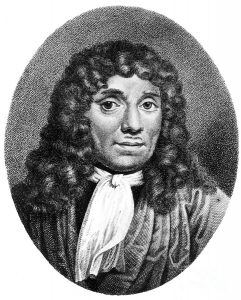
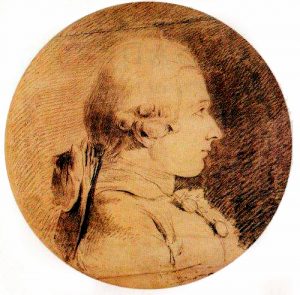 |
| Alphonse Donatien Francoise, Comte de Sade. (1740-1814) Alternating senior de Sades use ‘Comte’ or ‘Marquis’, and posterity has decided on Marquis. |
On this day, 276 years ago, Donatien Alphonse Francoise was born in Paris to a French diplomat and his wife who were not getting along any too well… I would wish him a Happy Birthday today, but his singular achievement seems to have left Western philosophy in a bit of a bind about what kind of happiness we should want to have!
Richard von Krafft-Ebing chose as his poster boy for the paraesthesia for sexual satisfaction in the infliction of pain, degradation and suffering a far more famous and imposing figure than Leopold von Sacher-Masoch. He selected the most notorious libertine, the Marquis de Sade. De Sade is an imposing figure of the Age of Reason because, relative to the company of social, political and economic giants, he was the only one dead set against reason. Despite spending nearly half his adult life jailed, he is remembered today precisely for his demand for absolute freedom and rejection of reason and law. He was acutely ironic figure, for he particularly detested religion even as the age’s greatest philosophers were coming up with new discourse justifying it even as it was declining in power, yet he was heavily persecuted for religious reasons. Whatever he didn’t like about authority, he was utterly inept at resisting it.
Because de Sade’s influence on modern thought greatly exceeds von Sacher-Masoch’s, it will not be possible to be encyclopedic about his life and influence in a short essay. Born 100 years before von Sacher-Masoch, he had already been subjected to much more analysis and discourse than Von Krafft-Ebing’s other exemplar. The psychiatrist was far from the first to use the term ‘sadism’ which was courant long before Psychopathia Sexualis. But de Sade influenced Nietzsche, Apollinaire, Barthes, Genet, Breton, Sartre and de Beauvoir, Bakunin and especially, Sigmund Freud. Through them, he goes to the core of our notions of modernity, freedom of expression and individualism, even those of us that find him repellant.
How did such an impulsive, defiant, and aggressive man become so important in Western thought? That requires a good deal of historical context. de Sade came along at a juncture of Western civilization in which social change was altering traditional ideas about the relationship between the individual and society and the sources of institutional legitimacy:
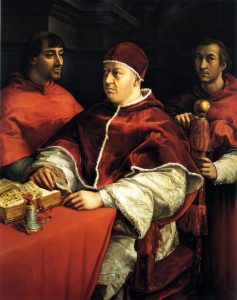 |
| Pope Leo X (1475-1521), by Raphael Pope Leo failed to reach accommodation with German princes and Martin Luther, precipitating the 30 Years War and Wars of Religion. |
Religious absolutism was being challenged: Prior to the Enlightenment, the Roman Catholic Church had the power to dictate what reality was. Then Protestantism arose to challenge for that power. Recoiling from the ferocious and devastating Wars of the Reformation, Roman Catholicism and Protestantism had battled to a standstill. The Western thinkers were looking for reasons to stop fighting, and one of the solutions was reason itself.
New scientific breakthroughs and the beginnings of industrialization and spreading literacy were democratizing the discourse about how government should work and how knowledge about the world could be gained. Newton discovered gravity, Galileo observed its workings on the ground and in the heavens. The science of optics was invented, human cells observed for the first time, and maps profited from the Cartesian coordinate system and navigation based physical principles. Direct observation of the natural world was yielding scientific breakthroughs and challenging religious authority.
 |
| Francoise-Marie Arouet (1694-1778) You are more likely to know him as Voltaire. Like de Sade, he was an ardent critic of the Roman Catholic Church. |
Redefinition of politics: Europe and the colonies in America were in a discussion about reason as an alternative to faith. At a time when every major European country had an official state religion, the nascent United States of America would simultaneously bring about constitutional protections for religion, but also protect government from official religious affiliation. Soon, that thinking was going to infect France. de Sade was a powerful voice in the context of that time.
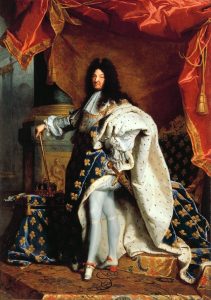 |
| Louis XIV of France (1638-1715) “I am the state.” |
Louis XIV had marked the high water mark of absolutism. He had uttered the famous dictum “L’etat, c’est moi”, literally “The state, that’s me!” and he had the leadership ability to pull off so grandiose a claim. But his heirs were not nearly as able, nor as long lived, nor as fortunate as Louis XIV had been. The state that seemed to function so well under Louis XIV that it was the envy of all Europe lacked sufficient system of public finance, and, following the expulsion of the Protestant Huguenots, had a depleted merchant class just when commerce was becoming crucial to state finance. When he died in 1715, the proper functions of government were tilting towards greater democracy and individualism because absolutism was failing. Epicureanism, republicanism, and freedom of thought preoccupied philosophy.
Libertinage:
 |
| John Calvin (1509-1564) As Calvinism spread, Libertines were originally reacting against his determinism. |
Libertinage arose from the conflicts between the prominent Protestant John Calvin and French Catholicism. Calvin preached religious absolutism in Geneva in opposition to the militant Catholicism that later revoked the Edict of Nantes (1598, revoked 1685) and drove the Protestants out of France. Distaste for Protestant determinism led philosophers to questioning whether Catholic and Protestant doctrines might both be incorrect. Libertines were people who stuck up for the right to consider the possibilities that neither faith was the ultimate truth. Initially, libertinage had nothing to do with sexual freedom, it was about freedom to rethink doctrine. Free-thinking would influence philosophy in many ways, not the least the philosophical justifications for the American Revolution; states governed for the benefit of the people, by the consent of the people, and dedicated to life, liberty -there it is now-and the pursuit of happiness. The happiness referred to here that government is instituted among men to pursue is a rational happiness. It fits well with the unruly political actors of Hobbes and Locke, the self-interested economic actors of Adam Smith and the separation of powers of Montesquieu. All of this would thrive under people who, freed from original sin by Jean-Jacques Rousseau’s insight that people were born good until corrupted by bad institutions, could best govern themselves. If people are born innocent and capable of making their own political decisions, then perhaps their sexual choices should be free and are inherently good too!
De Sade was far from the only Libertine to have seized the license to pursue his selfish sexual interests. It didn’t take long for people to recognize that if they were free to reject religious doctrine, they could be freed from religious notions of sexual restraint. But Sade insisted on his right to indulge all of his passions without restraint, and maintained that no other criteria, not reason, law, or even the consent of others should stand in his way. Sade bought Rousseau’s notion that man was the sum of his passions, but declined to restrain himself to that which was socially licensed as good.
This is a fascinating twist on Rousseau, whose defense of passion was actually performed in the service of defending religion. Rousseau saw reason as partly antithetical to spirituality. If science was vastly more capable than previously thought of explaining the natural world that God had created, and people were born innocent, what was the proper basis of religious belief? Rousseau’s answer was that passion was the basis for faith. De Sade, who’d seen the passion to inflict harm and to dominate in religion was not giving Rousseau a free pass to conjure up a modern idyll grounded on idealizations of innocence. In doing this, de Sade rubbed Rousseau’s nose in the problem of power. Perhaps because the Comte de Sade never recovered from exactly that same demonstration when it was perpetrated upon him.
de Sade’s life:
 |
| 18th century corporal punishment was not just practiced upon children. |
De Sade was born in Paris in 1740. Although de Sade was his parents’ only surviving child, his father abandoned the family, his mother joined a convent. de Sade was raised by an indulgent uncle and was soon widely regarded as spoiled even as an aristocratic child. Sent to an abbey for his early education, he was subjected to the severe corporal punishment that was characteristic of Jesuit education of the age. The Jesuits in the 1740’s had not yet gotten Rousseau’s message that children were born innocent! It is easy to imagine the intensity with which the Brothers and Sisters attempted to whip the Devil out of de Sade. de Sade became obsessed with corporal punishment even before he was out of his teenage years and developed a passionate hatred of the Church. At age 14 he was sent to military school, and then entered military service and rose to the rank of colonel in the dragoons in time to participate in the 7 Years War ending in 1763. Military service had agreed with him well enough, he had risen rapidly through the ranks despite the fact that France did poorly, and war debt would be a factor in the coming French Revolution.
 |
| Chateau Lacoste today, with a statue commemorating the Marquis’s incarcerations and defiance. |
The young colonel mustered out in 1763 and lived near Paris where he got into several altercations with prostitutes (he insisted in incorporating crucifixes in his sexual acts which offended the prostitutes and was regarded at the time as the serious crime of blasphemy) and was briefly imprisoned. The family forced de Sade to marry, in hopes this might end his embarrassing activities, but there is little to suggest this restrained him. By 1768 he had been banished to his family’s estate Chateau Lacoste, in Provence and far from Paris. Shortly thereafter he lured a beggar woman, Rose Keller to his property with the promise of employment, then launched on a campaign on nonconsensual behaviors including tying her up, making incisions on her and pouring hot wax in them. After hours of this abuse she escaped by jumping from a second story window. De Sade’s mother-in-law became involved in the ensuing criminal matter and obtained a lettre-de-cachet from Louis XVI to have de Sade imprisoned without the need for a trial. She was a devout religious person, and de Sade and she loathed one another, no doubt in part due to complaints from de Sade’s wife. Eventually, De Sade was banished or escaped to Italy in the company of his wife’s sister (yes, they had an incestuous relationship), where he was again incarcerated and escaped. He returned to Lacoste, where he hid for a time and became involved in a prosecution for sodomy with several prostitutes and his manservant. Although sodomy was widely practiced and tolerated among the aristocracy in pre-revolutionary France, de Sade’s mother-in-law saw to it that he was fully prosecuted. Eventually de Sade was lured to Paris on the pretext that his mother was dying. There he was arrested and incarcerated for about a decade in the prison at Vincennes. De Sade also spent time in the Bastille, where he was far from a model prisoner. On July 8, 1789 he was heard yelling to a gathering mob that the authorities were killing all the prisoners. On July 14, 1789, the mob stormed the Bastille, the symbolic opening of the French Revolution, but two days too late to liberate the Marquis, who was relocated to La Conciegerie. In fact, the authorities had not executed anyone, but all but seven of the prisoners were removed before the prison was liberated by the people. Nonetheless, in the French mythology of the Revolution, de Sade practically started it!
During his incarceration, de Sade became a prolific writer. And this is the source of his protracted influence on Western philosophy. I am not a huge fan of his work, but de Sade wrote compulsively. He could be an incisive and provocative social critic. His sexual writings dwell heavily on corrupting others, hatred of church and other officials who inflict atrocities on the helpless, and compulsive escalating scenarios in which his characters top themselves by repeatedly doing more extreme, intense, cruel and numerous abuses.
If inflicting pain and degradation are not your thing, and blasphemous descriptions of venal churchmen don’t tickle your transgressive funny bone, you are in danger of finding his work boring and very repetitive. Two stars!
 |
| The manuscript of 120 Days of Sodom preserved by Iwan Bloch, now in French hands within the Museum of Letters and Manuscripts in Paris |
But on another level, de Sade’s drive to express himself is that of any writer, and he was nothing if not urgent about his need to speak. While incarcerated in the Bastille, he was deprived of pen and ink and wrote the manuscript for 120 Days of Sodom in ‘blood and excrement’ on a huge role of paper smuggled in one square at a time and the glued together. It was hidden, and re-found and published by the pioneering sexologist Iwan Bloch at the beginning of the 20th Century. Some critics claim that the plot is derived from the life exploits of Gilles de Rais, a famous lieutenant of Jean D’Arc who is notorious as a serial murderer of children, and Elizabeth Bathory, a Hungarian serial murderess of young girls. 120 Days of Sodom is a categorization of all of de Sade’s fantasies of penetrating, torturing and killing young people.
 |
| Storming the Bastille, July 14, 1789. |
One might have imagined that, with the removal of de Sade from the Bastille, his incarceration would have continued. However, in the early days for the French Revolution, the practice of lettres-de-cachetwas abolished and, despite his aristocratic heritage, he was freed, and even given a seat as a deputy to the national convention that sought to draw up a new French constitution. In 1790 he was out of prison and trying to get his works published anonymously. He was a member of the radical left, advocating against elites and for common people. As the Revolution entered its paranoid phase and devolved into the Reign of Terror, de Sade opposed it. He even intervened to preserve the life of his hated mother-in-law! When his son deserted the French Army, besieged as it was on all fronts by anti-revolutionary forces, de Sade narrowly avoided execution himself. As it was, when Maximillian Robespierre took power, de Sade was imprisoned for ‘moderatism’. This is probably the first and only time he was ever accused of that. But de Sade was so oppositional that he played a dangerous game. He went so far as to criticize the guillotines in the Pace de la Concorde as offensive for executing people for bureaucratic and civil reasons rather than out of pure passion. He was lucky to have escaped with a mere year in prision when over a thousand lost their lives. He was released in 1794 with the death of Robespierre, who eventually fed the maw of the guillotine he had unleashed. For the next several years de Sade was largely destitute, and lived in Paris, his Chateau Lacoste having been sacked earlier in the revolution.
During his period of penury, de Sade was able to get two his novels, Justine and Juliette published. They tell the stories of two sisters who are separated young and make diametrically opposite choices. Juliette embraces vice early on, gets drawn into perversions such as papal orgies but thereby is able to live a comfortable life and turn towards virtue. Justine is made of sterner stuff and fixes her star rigidly on virtue from the start, only to careen from one terrible misfortune to another and inadvertently cause great harm to others. Justine turns to the church, to the wealthy, and to the courts for justice only to be violated and exploited every time until she is finally rescued by her sister. No sooner is she freed by Juliette than she is struck dead by lightning. Unlike 120 Days of Sodom, Justine and Juliette are not mere catalogs of vice, but an active indictment of the futility of trying to live virtuously, and of the classic sources of authority.
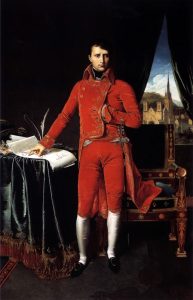 |
| Napoleon Bonaparte as First Consul by Jean Auguste Dominique Ingres |
In 1801, Napoleon Bonaparte came to power following his impressive military victories in Italy in war against Austria. He readJustine and Juliette, and pronounced Juliette “the most abominable book ever engendered by the most depraved imagination.” Napoleon signed the order personally to have its anonymous author imprisoned without trial. Later entreaties from his family removed de Sade to the French insane asylum in Charenton where he spent the final 13 years of his life. In Charenton, the Marquis’ reading and writing were mostly encouraged. He did write plays that were produced by the local populace outside the asylum, but not, as has been written in popular representations since, using the inmates as his actors. On Dec 2, 1814, de Sade died in Charenton.
Cultural Significance:
The Marquis de Sade’s primary cultural significance is as a bête noire or bogeyman. He is a cautionary tale about the depravity and tragedy that will befall us if we give ourselves over to our innermost natures. This role was already well established by the late 19th century when Richard von Krafft-Ebing took him up as the exemplar and the name for his perversion of sexual satisfaction at the suffering and degradation of others. But, aside from Freud, most depictions of de Sade represent his general satisfaction at making others suffer, rather than his sexual response. So the term sadism in common usage has lost its explicitly sexual origin. de Sade and his acolytes remain staples of modern horror mythology.
De Sade considered his depictions of sex as naturalistic, just as Rousseau’s ‘noble savage’ was a description of man’s natural condition. de Sade opposed supernaturalism, and thereby considered himself a kind of natural philosopher of human sexuality. This idea would be affirmed by Iwan Bloch and the early sexologists, who saw in his work a kind of encyclopedia of perversions. Freud would incorporate this idea into his notion of the id, much taken by de Sade’s conflict with authority. Freud’s eternal conflict between our inner morality and instinctual impulses owes something to de Sade. Likewise, Andrè Breton, one of the founding fathers of the surrealist movement took up this Sadean unconscious as the goal of surrealistic representation, and images of suffering, dismemberment and decay in Salvador Dali owe a little to de Sade. For more of this than you can take, take as much of a look as you can at the opening eye sequence in Un Chien Andalou, Breton’s classic of surrealist cinema. Breton is responsible for referring to him as “the Divine Marquis” in celebration of his ability to see into the same inner truth of our natures that the surrealists were at pains to depict.
 |
| Simone de Beauvoir, author of the The Second Sex, and ardent opponent of censorship. |
de Sade also retains huge influence today as a symbol in the struggles between artists and censors. In 1957, the French government came into possession of the original manuscript of 120 Days of Sodom, and debated destroying it. Simone de Beauvoir, the famous French existentialist and author of The Second Sex wrote and important anti-censorship essay Must We Burn Sade? That essay grounds existential authenticity in passion, not principles, and de Beauvoir defends Sade as the existentially authentic despite his crimes, basing all of this on his criticism of institutional murder during the Reign of Terror. It is difficult today to imagine the resonance of such an argument for a country that had been occupied by hated German oppressors, and had forced to collaborate in the transportation of dissidents and Jews to the death camps of 1940-45. For modern free-thinkers de Beauvoir and Sartre, de Sade’s hatred of privilege and institutional power were important corollaries to personal responsibility, even if his behaviors were crimes. Ultimately, the manuscript of 120 Days of Sodom was not burned and is treated as a national icon, although its acquisition and display lagged the famous essay by 50 years.
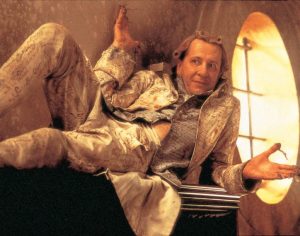 |
| Geoffrey Rush as the Divine Marquis in Quills (2000) |
The other great exploration of de Sade as resistance to repression is Doug Wright’s Quills, a meditation on art and censorship. Played fearlessly by Geoffrey Rush in the 2000 film adaptation, Rush was nominated for an Oscar. The manic, chronically provocative de Sade is locked in mortal combat with an enlightened doctor who has been sent by Napoleon to ‘cure’ the madman who wrote Justine. While the play and movie take considerable liberties with history, they capture de Sade’s struggle against authority and repression brilliantly. There is a good chance you are looking at decent approximation of the ‘real’ Marquis de Sade in Rush’s performance. De Sade never sat for a proper portrait, so we have only a rather effete and beautified engraving of his likeness. It does not do historians any good that his humiliated family destroyed many of his writings and did their best to minimize the damage he did to the family name by eradicating his history. He was never discussed among the family for five generations, and many of his writings were destroyed. It is safe to say that if his portrait had ever hung in the family gallery, it had long since been taken down.
de Sade’s hatred of authority influenced the 19thcentury nihilists who claimed that power was too corrupted to serve as a constructive source of meaning. Had de Sade lived to debate this, I suspect he would have denied this conclusion, claiming instead that meaning lies in the natural expression of his passions, but would have taken delight in the trouble nihilism was to cause. Had he lived, de Sade would have been panicked by the rise in state power that followed the Second Industrial Revolution and World War I.
The Divine Marquis and Kink:
Were Alphonse Donatien Francoise alive today, there is a good chance he’d be in jail, but he would be endlessly celebrating modern kink. That he might have inspired others to debauchery over two hundred years after his death would delight him. But he is a highly ambivalent figure for modern kinksters. We have come to accept the Freudian insight that we are inherently ambivalent in a way that de Sade strove to avoid with his flamboyant acting out. De Sade’s natural man may well have been murderous, but he was not ambivalent. He would have had no tolerance for our ambivalence about him!
de Sade regarded consnet as a token concession to authority, which by its very nature, existed to privilege some to have their desires and to deliver others up to them. So modern kink has had to disavow de Sade, even in the face of elements of the community who have argued against the doctrines of Safe, Sane and Consensual for just this reason. Sade negotiated nothing, and regretted nothing in his writings. This is why von Sacher-Masoch had the opportunity to introduce the ideas of consent, negotiation and contract 75 years later. And resistance remains to any need to negotiate one’s impulses because it lessens the perceeived power of toping and pure freedom of bottoming. But only a self-destructive few are so wedded to their fantasies of extreme surrender that they are willing to knowingly dispense with the need for consent. When John Wayne Gacy advertised on Alt.com and lured gay men to their deaths, de Sade would have seen integrity and authenticity where we see only tragedy and murder. Modern kinksters don’t really worship at the altars of Bathory and de Rais.
 |
| Maggie Gyllenhaal in The Secretary. Its not really about routine office power relations, is it? |
Kinksters bemoan the social confabulation of sexual sadism with the routine sublimated joys of degrading others. Plenty of opportunity exists in organizational life for routine dominance and submission, and part of what makes kink exotic and special is counter-cultural lust to take dominance and submission out of the desexualized, prosaic, and mundane contexts in which we all ordinarily have to do these things. That is the fun of The Secretary in which Maggie Gyllenhaal and James Spader infuse their professional relationship with lusty kink despite no explicit sexual relations. This dynamic often applies even of those who claim that their primary satisfactions from kink are not ‘sexual’. Perhaps not, but they are even more emphatically not mundane or utilitarian. de Sade was already known to have applauded this as we saw in de Beauvoir’s essay. Indeed, part of what made de Sade shocking in the 18th century was that he used lust, not utilitarianism, to justify his protagonsits’ behaviors. The same treatment of slaves was in many places not even criminal. So modern kink and de Sade are strongly allied in making kink passioante, not utilatiarian, in its ultimate motives. Although de Sade distrusted religion, I believe he would have applauded those who seek spirituality in sensation play as long as it did not conform to institutionalized religious power structures.
De Sade never saw power as exchanged. He desired to corrupt others by inciting and shaping their desire. That struggle has been displaced in modern kink to obtain consent under conditions of ambivalence. Power is experienced in getting the ambivalent so excited that they face their fears when highly afraid! De Sade was never satisfied that he had had all the fun he could until dozens were destroyed. So the modern irony is that kinksters love to play out imitations of de Sade, while fearing to encounter a ‘real’ one. And no matter how glamorous his ideas may seem, de Sade was a rapist. When feminists and conventional moralists attack kink as violence, it is this image of de Sade that makes BDSM’s discussion of consent seem like superficial rationalization to them no matter what de Beauvoir wrote.
The Marquis and the DSM:
If the Marquis de Sade were alive today, no Krafft-Ebing or DSM would be needed to diagnose him anymore than the forerunners of psychiatry were needed at the turn of the 19th century. The real de Sade broke countless laws, and his modern counterpart would do the same. If called upon to diagnose him, the emphasis would be on which personality disorder was needed to describe him. Was he borderline, narcissistic, or just antisocial? Ultimately, antisocial personality disorder better describes de Sade than sexual sadism, which he also had (and pedophilia, hebephillia, voyeurism and exhibitionism. But all in the service of defying our norms and laws about how individual power must be limited. For de Sade was not compulsive about which sexual behaviors he preferred, but that they be transgressive.
There is a superficial similarity between the childhood life stories of de Sade and von Sacher-Masoch. Both are raised Roman Catholic. Both are subjected to harsh corporal punishment, and both become feverish writers of kink. Both become manifestly self-defeating. But this simple equation belies a much more complicated and mysterious picture about the relationship between childhood corporal punishment and subsequent kink. Although the cultural contexts of mid-eighteenth French and mid-nineteenth Austrian cultures had many similarities, both widely license corporal punishment for children, yet these cultures produced few de Sades and Sacher-Masochs, even allowing for singular genius in their aptitudes for writing. We can imagine von Sacher-Masoch discovering ecstasy in the adrenaline/endorphin rush that accompanied beatings he was forced to experience, but surely many similar child victims of beatings experienced this without the intensity of connection that imprinted this particular gifted boy. De Sade, rather than reveling in the sensuality of his neurochemicals, identified with the power to force and degrade others. In this, he is the perfect case study for Alfred Adler, whom we will take up much later[i]. Was he somehow able to activate his adrenaline and endorphins by identifying with the exquisite suffering of his victims? We know that he occasionally had himself whipped during sex, an idea that is as old as time itself and certainly familiar to well-read libertines.
But the superficiality of von Sacher-Masoch’s and de Sade’s early experiences with corporal punishment did not account for their differences. De Sade, for all his extolling of the virtues of unlimited power over others, was strikingly intolerant of being on the receiving end of such abuse. Yet he did not start getting into real trouble throughout his army career, where discipline was no less tight than in Jesuit education. Note, however, de Sade had ever increasing power as a rising cavalry commander, which he did not have as a student in the abbey, nor after he mustered out aristocrat in Paris.
Ultimately, we do not know why these two life histories took such different turns. Early history of corporal punishment may have loaded the dice, but did not dictate their outcomes.
For a time, the DSM flirted with the diagnosis self-defeating personality disorder. Although this had nothing to do with his professed ideology, but when one examines Alphonse Donatien Françoise’s life history, de Sade seems to have allowed himself a rather limited expression of his natural instincts so vividly and compulsively displayed in his writing. Despite the privilege of his rank in pre-revolutionary France, he got prosecuted for a string of fairly minor (relative to his writings) sex crimes. Despite a passionate sympathy for the revolution, he got himself incarcerated by Robespierre for being too moderate. Despite being allowed to write and produce plays for the citizens of Charenton, he got forbidden to write for a time. And he had no trouble so offending Napoleon that he was imprisoned merely for writing.
 |
| Napoleon crowns himself while the Pope watches in Bonaparte’s 1804 coronation as Emperor of France. Detail from The Coronation of Napoleon by Jacques-Louis David (1808) |
And this makes for a stunning contrast. Napoleon Bonaparte, then the French First Consul, thought so highly of himself as the ultimate new revolutionary man that, three years later, he would not allow the Pope to crown him, and instead crowned himself Emperor of the French December 2, 1904; and de Sade, a man who repeatedly assaulted a poor washer woman, gave too much Spanish fly to a prostitute, and had sex with his manservant, squared off against one another other. Napoleon was the most brilliant military mind of his time whose behavior, directly and indirectly, led to the 4.1 million deaths of the Napoleonic Wars. I am rather glad that neither is my next door neighbor, but please do not ever imagine for a moment that the Marquis de Sade is everybody’s ultimate boogeyman and Napoleon is just a great general from the past because it suits the legitimization of institutional power to tell the story that way. The Marquis de Sade is no hero. But he bemoaned the routine destruction of life to enforce the power elite, while Napoleon spent lives liberally to sustain and enhance his power. de Sade may not be my idea of a healthy person or a hero, but he comes off pretty well in comparison with the French Emperor who jailed him.
[i] Alfred Adler was an early Freudian who came to disagree with Freud about centrality of the Oedipus Complex. Adler thought power was a key underlying motive, and came up with the theory of masculine protest, and the still current idea of identification with the aggressor. He would have argued that de Sade became obsessed with taking on the powerful role of the punishing religious teachers who had disciplined him as a youth.
© Russell J Stambaugh, June, 2016, Ann Arbor MI, All rights reserved
